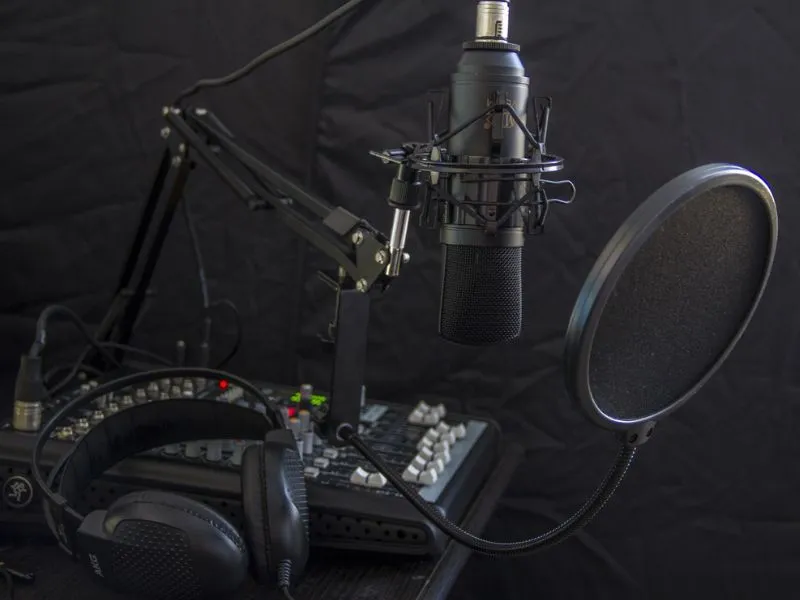What are the different types of Microphones
Microphones
Microphones are an indispensable tool in the world of audio recording and reinforcement, playing a pivotal role in capturing sounds ranging from the soft whispers of a vocal performance to the roaring intensity of live instruments. However, not all microphones are created equal, and understanding the differences between them is crucial for anyone involved in audio production, whether you're a budding podcaster, an aspiring musician, or a professional sound engineer. The world of microphones is vast and varied, encompassing various types that are tailored to specific applications and sound sources.
This article highlights the three main types of microphones: dynamic, condenser, and ribbon. Each type has its unique characteristics, operating principles, and areas of application, making them better suited for certain tasks than others. By delving into the specifics of each microphone type, we’ll provide a comprehensive overview that not only highlights their differences but also guides you in choosing the right microphone for your specific needs.
Dynamic Microphones
Dynamic microphones are the workhorses of the audio world, known for their durability and versatility. These microphones operate on the principle of electromagnetic induction. A diaphragm within the microphone moves in response to sound waves, causing a voice coil attached to the diaphragm to move within a magnetic field, thereby generating a small electrical signal.
The rugged construction of dynamic microphones makes them ideal for live performances and situations where the microphone might be subject to rough handling. Moreover, their ability to handle high sound pressure levels (SPLs) without distortion makes them the microphone of choice for loud sources, such as guitar amplifiers and drums.
Though highly capable, dynamic microphones generally have a more limited frequency response compared to the other microphone types, which can result in a less detailed sound reproduction for nuanced acoustic performances.




Condenser Microphones
Condenser microphones, also known as capacitor microphones, are prized for their sensitivity and wide frequency response, making them the go-to choice for studio recordings and situations requiring precise sound capture.
Unlike dynamic microphones, condenser microphones require an external power source, usually provided by what's known as phantom power, supplied through the audio interface or mixer to charge their internal electronics. The heart of a condenser microphone is its capacitor, which consists of a fixed back plate and a movable diaphragm that acts as the capacitor's second plate. Sound waves cause the diaphragm to move, changing the distance between the plates, and thus altering the capacitance, which is then converted into an electrical signal.
This design enables condenser microphones to capture sound with a high level of detail and clarity, making them ideal for capturing the subtle nuances of vocals, acoustic instruments, and ambient sounds.
Ribbon Microphones
Ribbon microphones, with their distinct warm and natural sound, are valued for their ability to capture audio with a vintage character. These microphones use a thin, lightweight metal ribbon suspended between the poles of a magnet to generate an electrical signal. As sound waves hit the ribbon, it moves within the magnetic field, creating an output signal.
Ribbon microphones are known for their figure-eight polar pattern, which picks up sounds from the front and back of the microphone while rejecting sounds from the sides. This makes them excellent choices for capturing room ambience and for use in situations where a natural blend between the direct sound and the room sound is desired. However, ribbon microphones are generally more delicate than dynamic and condenser microphones, requiring careful handling to avoid damage to the ribbon.
They fell out of favour for many years due to their not recording well, with the top-end loss of analogue desks and tape medium making them sound dull compared to condenser microphones. The move to digital recordings has seen their return to studios, and they are highly regarded for their natural sound.


Read More...
Microphone Technologies and Applications
Microphones, the gatekeepers of sound, transform air vibrations into electrical signals, acting as the initial step in the audio recording and amplification chain. The technological nuances that distinguish dynamic, condenser and ribbon microphones not only affect their sound quality but also determine their ideal applications. Understanding these differences is crucial for both novices and professionals in selecting the right microphone for a given situation.
The Technical Backbone
At the heart of each microphone type lies a unique transducer mechanism, which is responsible for converting sound into an electrical signal.
Dynamic microphones utilize electromagnetic induction, where sound waves cause a diaphragm to move, generating an electrical signal without the need for external power. It’s similar to the operation of a loudspeaker, just in reverse order. This principle underlies their robustness and reliability, especially in live settings.
Condenser microphones, on the other hand, employ a capacitor to capture sound. The distance between the diaphragm and a backplate changes with incoming sound waves, altering the electrical charge stored in the capacitor. This design requires external power to maintain the charge, usually supplied as 48 volts from the mixing desk, enabling these microphones to capture sound with greater fidelity and sensitivity. Their wide frequency response and high detail make them unparalleled for studio applications, where capturing the subtle nuances of a performance is paramount, but also make them unsuitable for stage use as they are just to sensitive.
Ribbon microphones, the venerable elders of the microphone family, rely on a simple yet elegant design featuring a thin metal ribbon that vibrates with sound waves. This movement within a magnetic field generates the electrical signal. Ribbon microphones are known for their smooth frequency response and natural sound, closely mimicking the way humans perceive sound in an environment. They are fairly delicate devices, and due to their figure-of-eight capture pattern are not generally seen outside of recording studios.
Microphone Application
The choice of microphone heavily influences the tonal characteristics of the recorded audio. Dynamic microphones, being less sensitive, are adept at capturing loud, dynamic sources without distortion, making them ideal for live vocals, drums, and electric guitar cabinets. Their durability also means they can withstand the rigours of touring and live performance environments.
Condenser microphones shine in controlled studio environments where the accuracy of sound reproduction is critical. Their sensitivity and wide frequency response make them perfect for vocal recordings, acoustic instruments, and any application where capturing the slightest detail is desired. They have recently found a wide user base for the recording of podcasts and live-streaming. However, their sensitivity means they can be prone to picking up unwanted background noise if not used in an adequately treated space.
Ribbon microphones, with their figure-eight polar pattern, are excellent for capturing a blend of direct and ambient sounds. They are particularly favoured in studio environments for recording vocals, string instruments, and brass, where their ability to smoothly capture the warmth and detail of these sources is unmatched. They do however require matching to a good quality preamp that can provide the gain and input impedance necessary for optimal performance.
Karaoke Microphones
Microphones sold specifically for karaoke users will be dynamic in design as they need to be as tough as possible. The general public won't have the knowledge or respect to not scream, shout, or drop your expensive vocal mic, so a range of lower-cost microphones have been created especially for that need. They often feature plastic bodies rather than metal, and non-removable pop shield guards.
You can find variations of the karaoke microphone design aimed at the home party and children's market. These can be found with extras such as built-in LED lights, or even selectable electronic vocal effects such as echo. The are designed to be compatible with a wide range of karaoke machines and home audio systems, so will usually be a cabled connection using a 6.35mm jack plug, as opposed to the balanced XLR found on professional microphones.
Shotgun Microphones
Another type of condenser mic, shotgun microphones are a staple in the television industry. They are highly directional mics designed to capture sound from a specific area while minimizing noise from the sides and rear. This unique characteristic stems from their supercardioid or hypercardioid pickup patterns, making them ideal for uses where focusing on a singular sound source is essential—think film production, wildlife recording, or capturing dialogue in noisy environments.
The secret to their directional magic lies in the microphone's elongated design, which incorporates an interference tube in front of the diaphragm. This tube enhances sound waves coming directly from the front, while sound waves arriving from off-axis angles are cancelled out, significantly reducing ambient noise and improving the clarity of the recorded sound.
Despite their prowess in isolating subject sounds, shotgun mics do have limitations. Their performance can vary with the frequency of the sound source; lower frequencies are less directional, which can sometimes lead to a less isolated audio capture. Additionally, they're not suited for every recording situation due to their highly directional nature. Understanding when and where to use these microphones can greatly affect the quality of your audio recordings, making them a powerful tool in the right hands.
Boundary Microphones
Boundary microphones, often overlooked yet incredibly versatile, excel in capturing audio in a wide range of environments. These condenser microphones are designed to be placed on a flat surface, such as a table, wall, or floor, which effectively leverages the boundary effect. This phenomenon occurs when sound waves are reflected off a surface, combining with the direct sound to enhance clarity and richness without the phase issues typically associated with closely positioned microphones.
One of the standout features of boundary microphones is their ability to pick up sound from a wide area, making them ideal for recording meetings, conferences, theatrical performances, and even for use in surveillance. Their omnidirectional pickup pattern ensures that sound is captured uniformly from all directions, which is particularly beneficial in settings where multiple speakers are involved or where the sound source moves around.
Moreover, the low-profile design of boundary microphones allows them to be discreetly positioned, avoiding visual distraction and minimising the intrusion into the space being recorded. This discreetness, combined with their exceptional sound capturing capabilities, makes boundary microphones a favoured choice for situations requiring non-intrusive yet high-quality audio recording. Whether it's capturing the ambience of a live performance or ensuring every participant's voice is heard in a conference, boundary microphones offer a unique and effective solution.
Navigating the Soundscape
Understanding the characteristics and applications of each microphone type allows audio professionals and enthusiasts to navigate the complex soundscape of recording and live sound reinforcement with confidence. Dynamic microphones offer ruggedness and reliability for onstage use, condenser microphones provide precision and detail for studio recordings, and ribbon microphones bring warmth and naturalness, ideal for capturing the essence of acoustic performances.
The other thing to consider is that recordings will be using several, if not all three types, depending on the instruments being played and the vocal requirements of the mix. It's simply a case of the right tool for the job. As they all perform very differently to each other. In choosing the right microphone, consider not only the sound source but also the recording environment and the desired tonal characteristics of the final audio. Experimentation and experience are key in finding the perfect match, as the subtleties of microphone placement and selection can dramatically affect the outcome of a recording or performance.
As technology advances, new microphone designs and innovations continue to expand the possibilities of sound capture, but the fundamental principles behind dynamic, condenser and ribbon microphones remain the foundation of audio production. Understanding these principles is essential for anyone looking to master the art and science of sound.


